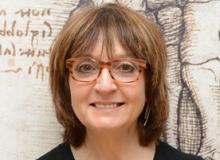
The National Academy of Sciences recently elected new members Drs. Elizabeth Buffalo, Hollis Cline, Stephen Lisberger, Helen Mayberg, and Jay Shendure for their distinguished and continuing achievements in original research.
The National Academy of Sciences (NAS) recently announced 120 newly elected members and international members. Among the 2022 electees are Drs. Elizabeth Buffalo, Stephen Lisberger, Helen Mayberg, and Jay Shendure, who are BRAIN-funded researchers, and Dr. Hollis Cline, a former BRAIN Multi-Council Working Group member. The NAS provides independent, objective advice to the nation on science and technology.

Dr. Elizabeth Buffalo studies the neural mechanisms behind learning and memory. In 2011, Dr. Buffalo won the Troland Research Award from the NAS for her study of the hippocampus and the neural basis of memory. At the University of Washington, she is Chief of the Neuroscience Division of the Washington National Primate Research Center. Her lab has three areas of focus: neural signals for memory in the human brain; eye movements and memory; and aging and memory. Dr. Buffalo’s BRAIN project includes parallel studies in monkeys and humans to investigate interactions between the hippocampus and surrounding cortical regions using large-scale recording techniques. Specifically, the project investigates how hippocampal-neocortical interactions create new memories and retrieve old ones. The research aims to ultimately help improve therapies for people with diseases that impact memory, like Alzheimer’s disease, depression, and schizophrenia.

Dr. Hollis Cline is a former member of the BRAIN Multi-Council Working Group, which provides ongoing oversight of the long-term scientific vision of the BRAIN Initiative. Dr. Cline is known for her research on how the brain uses sensory experiences to develop, maintain, and organize visual circuits. At Scripps Research, Dr. Cline is a Hahn Professor of Neuroscience and Chair of the Department of Neuroscience. Her current research projects investigate changes in brain network connectivity, how visual experience controls neuron formation in the brain, and the role of inhibition in visual circuit function and behavior. Dr. Cline has been well recognized for her work in understanding how experiences and activities control brain development—in 2019, she was awarded the Society for Neuroscience’s Mika Salpeter Lifetime Achievement Award.

Dr. Stephen Lisberger examines how the brain receives and transforms sensory inputs into coordinated movements. At Duke University, Dr. Lisberger is the George Barth Geller Distinguished Professor for Research, Chair of the Department of Neurobiology, and a faculty network member of the Duke Institute for Brain Sciences. His lab studies the neural circuits of eye movements in behaving rhesus monkeys using neural recordings and computational analyses. Dr. Lisberger’s BRAIN project investigates the cerebellum—particularly, the cerebellar cortex to understand its role in teaching the brain about movements and how to time them. The project uses optogenetics, machine-learning, electrophysiology, imaging, and computer modeling to investigate all relevant cell types of the cerebellar circuit to gain a better understanding of how the cerebellum functions to support motor learning. This work may help scientists further understand neurological conditions that impact movement, like stroke and developmental motor disorders.

Dr. Helen Mayberg is a trailblazer in the field of deep brain stimulation (DBS) research and renowned for her work in brain circuits in depression, most recently winning the 2020 Frances & Kenneth Eisenberg Research Prize from the University of Michigan’s Depression Center. She is the founding Director of the Nash Family Center for Advanced Circuit Therapeutics at the Icahn School of Medicine at Mount Sinai, and formerly a professor of psychiatry, neurology, and radiology at Emory University. Her BRAIN project studies subcallosal cingulate white matter (SCC) DBS in patients with treatment-resistant depression. Dr. Mayberg’s work refines and optimizes DBS control strategies, with the long-term goal of optimizing treatment and providing markers of disease for patients with depression.

Dr. Jay Shendure is a geneticist and a leader in the realm of next-generation DNA sequencing to analyze genomes and measure biological factors that cause diseases such as cancer. He has won multiple awards for his work in genetics, including the NAS’s Richard Lounsbery Award for extraordinary scientific achievement in biology and medicine in 2019. At the University of Washington, Dr. Shendure is a Professor in the Department of Genome Sciences and a Howard Hughes Medical Institute Investigator. His lab develops and applies new technologies to gene science. Dr. Shendure’s BRAIN project studies single-cell brain mapping in rhesus macaque monkeys with the goal to develop a single-cell molecular atlas that allows scientists to study variations in chromatin assembly and transcription within each cell. Once completed, the rhesus macaque brain atlas will be the largest transcriptional and epigenomic single cell dataset for any primate organ yet.
